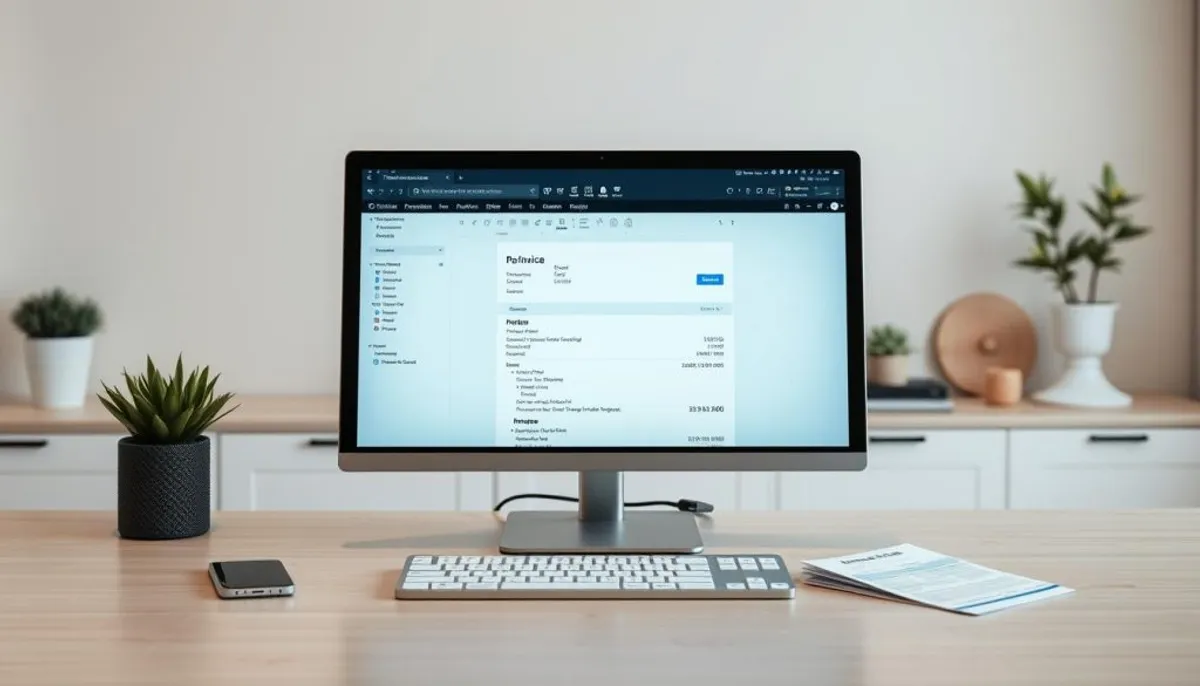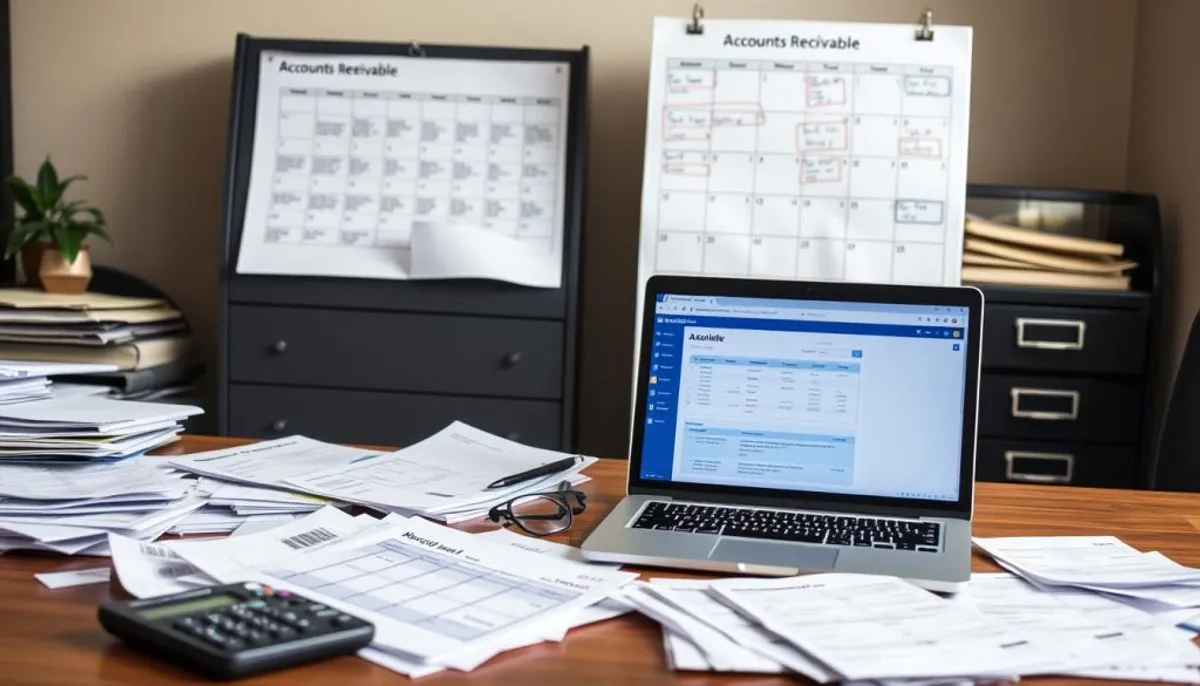Managing overdue invoices is a critical task for businesses of all sizes. Late payments have cost global companies over $3 trillion, making it imperative to craft effective email reminders for past due invoices. This guide will assist you in creating compelling late payment notifications that prompt clients to act swiftly.
Did you know that 1 in 10 invoices is not paid on time, and 10% are never settled? These statistics underscore the significance of a well-crafted overdue invoice email. By sending timely and professional reminders, you can enhance your chances of payment and ensure healthy cash flow for your business.

Effective past-due invoice emails must balance cordiality with firmness. They should clearly state the payment status, provide account details, and outline available payment options. The aim is to encourage prompt payment while safeguarding your customer relationships.
Key Takeaways
- Late payments cost global businesses $3 trillion annually
- 1 in 10 invoices is not paid on time
- 10% of payments owed become bad debt
- Effective emails should be cordial yet firm
- Include account details and payment options
- Send follow-up emails promptly when payments are late
- Clear communication of late fees can encourage timely payments
Understanding Past Due Invoices and Their Impact
Past due invoices present substantial hurdles for businesses, impacting cash flow and operations. We will explore the financial repercussions, common causes, and statistics related to late payments.
Financial Impact on Businesses
Overdue invoices can severely disrupt a company’s finances. Small business owners often dedicate 14 hours each week to pursuing client payments. This time could be more productively spent on growth and innovation. Late payments not only strain resources but also disrupt financial stability and harm client relationships.
Common Causes of Late Payments
Several factors contribute to delinquent account follow-up:
- Client financial difficulties
- Invoice errors or unclear payment terms
- Poor communication
- Inefficient accounts receivable collection processes
Statistical Overview of Late Payments
The impact of late payments is substantial:
| Metric | Value |
|---|---|
| Average time spent chasing payments | 14 hours/week |
| Payment speed improvement with AI reminders | 5 days faster |
| Typical invoice terms | Net-30 or Net-60 |
Businesses can expedite payments by adopting automated reminders and clear payment terms. These measures streamline accounts receivable collection, minimizing the need for extensive delinquent account follow-up.
Essential Components of a Past Due Invoice Email
Creating an effective email payment reminder is critical for managing outstanding balance communication. Given that 60% of invoices in the US are paid late, honing this skill is essential for maintaining business cash flow.
Subject Line Best Practices
Your subject line is the first impression of your email. It should be straightforward and to the point, mentioning the invoice number and due date. For instance, “Invoice #12345 – Payment Overdue”. This strategy can significantly increase open rates and prompt immediate action.
Key Information to Include
Every past due invoice email must include:
- Invoice number
- Original due date
- Amount owed
- Payment instructions
- Late fee policy
Providing these details minimizes confusion and accelerates the payment process.
Professional Tone and Language
It’s important to maintain a friendly yet firm tone in your outstanding balance communication. Be straightforward about the situation while offering solutions for any payment difficulties. This approach can enhance client responses and expedite payments.
| Email Component | Impact on Payment |
|---|---|
| Clear subject line | 25% increase in open rates |
| Detailed invoice information | 30% reduction in payment disputes |
| Professional tone | 40% improvement in client response |
| Multiple payment options | 20% faster payment processing |
Timing Your Email Past Due Invoice Communications
The timing of an overdue invoice email can significantly influence payment outcomes. It is crucial to send the first late payment notification immediately after the due date. This swift action demonstrates your financial diligence and boosts the likelihood of timely payment.
Research indicates that reminders sent 15 days after the due date result in payment in 22% of cases. To enhance success rates, consider sending a pre-due date reminder a week before the payment is due. This strategy can decrease overdue accounts by approximately 15%.
As the days pass, escalating your efforts becomes necessary. By the 30-day mark, 75% of companies that send reminders receive payment within a week. If the invoice remains unpaid, continue with follow-ups at 60 and 90 days past due. It’s important to note that after two months, businesses risk losing up to 60% of outstanding amounts if they fail to act.
Timing may vary based on your payment terms and client relationships. The essence lies in being consistent and prompt with your overdue invoice emails. This method not only increases payment chances but also fosters positive customer relationships during the collections process.
Creating Effective Payment Reminder Sequences
Developing a strategic payment reminder sequence is vital for maintaining a healthy cash flow. With 87% of businesses facing late payments, a robust system for managing aging invoices is essential. This article will guide you in crafting an effective reminder strategy, blending professionalism with urgency.
Initial Reminder Strategy
Begin your payment reminder sequence with a friendly approach. Send the first reminder about a week before the due date. This initial nudge is a courtesy, ensuring clients have received the invoice and are prepared to pay on time. Include essential details like the invoice number, amount due, and payment options to facilitate prompt action.
Follow-up Schedule
Implement a structured follow-up schedule to manage overdue invoices effectively. Send reminders on the due date, then at 30, 60, and 90 days past due. Utilizing automated payment reminders can streamline this process, ensuring consistent communication without overwhelming your team.
| Reminder Stage | Timing | Tone |
|---|---|---|
| Pre-due | 7 days before due date | Friendly reminder |
| Due date | On the due date | Polite notice |
| 30 days past due | 30 days after due date | Firm reminder |
| 60 days past due | 60 days after due date | Urgent request |
| 90 days past due | 90 days after due date | Final notice |
Escalation Process
As invoices age, escalate your communication strategy. Use stronger language in your reminders, mention late fees, and outline potential consequences like account closure or referral to collections. This escalation process conveys the urgency of payment while maintaining professionalism in your aging invoice management.
Professional Templates for Different Payment Stages
Creating effective email templates for past due invoices is essential for ensuring timely payments. With approximately 30% of invoices being paid late, businesses must employ robust strategies to maintain their cash flow. This section delves into templates tailored for various stages of overdue payments.
30-Day Past Due Template
For invoices that are 30 days past due, a gentle reminder is appropriate. Restate the invoice details and present payment options. This approach aids in recovering payments while safeguarding client relationships.
60-Day Past Due Template
When an invoice is 60 days overdue, a more pressing tone is necessary. Mention any late fees and suggest payment plan alternatives. This method often encourages clients who may have overlooked earlier reminders to take action.
90-Day Past Due Template
For invoices that are 90 days past due, a final notice is imperative. Clearly outline the consequences of non-payment and set a definitive deadline. This template must convey the gravity of the situation without irreparably damaging the business relationship.
| Template Stage | Key Elements | Tone |
|---|---|---|
| 30-Day | Invoice details, payment options | Friendly reminder |
| 60-Day | Late fees, payment plans | Urgent |
| 90-Day | Consequences, firm deadline | Final notice |
Consistent follow-ups can significantly boost collection rates by up to 40%. Customize your overdue invoice email templates for each stage to maximize effectiveness. Always uphold professionalism and clearly communicate payment instructions to expedite resolution.
Maintaining Customer Relationships During Collections
The delicate balance between collecting accounts receivable and nurturing customer relationships is a significant challenge. A study reveals that 54% of businesses face difficulties in managing long payment collection times. This issue not only impacts cash flow but also puts a strain on client relationships.
Effective communication regarding outstanding balances is crucial. Businesses that engage in open dialogue with their clients experience a 25% decrease in overdue payments. Regular check-ins, occurring every 7 to 10 days, can reduce late payments by 15%.

Email emerges as the preferred method for sending payment reminders. A staggering 70% of customers respond more positively to email notifications about payments. This approach maintains open communication while subtly reminding clients of their financial obligations.
Implementing flexible payment plans can significantly enhance success rates. Businesses that offer such options see a 20% increase in payment rates from late customers. This strategy demonstrates empathy and helps in preserving long-term relationships.
It is important to remember that satisfied customers spend more than double what dissatisfied ones do. A mere 5% increase in customer retention can lead to a 25% to 35% boost in profits. By prioritizing the maintenance of positive relationships during collections, businesses can secure payments while fostering customer loyalty.
Automated Solutions for Past Due Invoice Management
Managing overdue invoices poses a significant challenge for businesses. Fortunately, automated solutions offer a transformative approach to this issue. Let’s examine how these tools can revolutionize your aging invoice management process.
Benefits of Using ti3 Platform
The ti3 platform emerges as a formidable tool for managing past due invoices. It streamlines the collection process, conserving time and resources. With ti3, businesses can diminish manual follow-ups by 40%, enabling staff to concentrate on more vital tasks.
Features and Automation Capabilities
Ti3 boasts a suite of features aimed at simplifying aging invoice management:
- Automated payment reminders
- Real-time payment tracking
- Customizable email sequences
- Comprehensive reporting tools
These features collectively form a robust system for managing overdue accounts. For example, automated payment reminders can decrease the average time to receive payment by 15%.
Integration with Existing Systems
One of ti3’s standout features is its seamless integration with your current accounting and CRM systems. This integration ensures a smooth workflow and obviates the need for redundant data entry.
| Feature | Impact |
|---|---|
| Automated Reminders | 30% reduction in overdue invoices |
| Payment Tracking | 50% faster payment recovery |
| System Integration | 25% increase in operational efficiency |
By adopting automated solutions like ti3, businesses can substantially enhance their aging invoice management process. This leads to improved cash flow and stronger customer relationships.
Legal Considerations and Late Payment Policies
Understanding the legal framework surrounding late payments is vital for businesses engaged in debt recovery emails or late payment notifications. Many states have established regulations on late fees and interest charges. For example, some states limit late fees to 10% of the original invoice amount. Others do not have a cap but enforce grace periods ranging from 5 to 15 days.
It is imperative to clearly outline your late payment policies in contracts and on invoices. This clarity not only fosters good customer relationships but also ensures adherence to legal standards. In many jurisdictions, charging interest or late fees is permissible only if the client has been informed beforehand.
When formulating your late payment policy, consider these prevalent practices:
- Annual interest rates for late payments are often set at 10% (0.83% monthly)
- Late fees typically range from $25 to $50 per unpaid invoice
- Some states mandate written agreements to assess late fees
It is crucial to be aware that the statute of limitations for debt collection in the US varies from 3 to 6 years, depending on the state. Consulting with a legal professional to review your collection practices is advisable. This ensures they comply with local laws and regulations.
Preventing Future Past Due Invoices
Effective accounts receivable collection hinges on proactive measures to avert late payments. By adopting intelligent billing tactics and refining payment terms, enterprises can markedly diminish the burden of aging invoices. This approach is pivotal in streamlining financial operations.
Proactive Billing Strategies
Initiating upfront deposits or partial payments can fortify the likelihood of timely remittances. Offering rewards for early or punctual payments further incentivizes prompt settlement. The deployment of automated invoicing systems ensures precise and timely billing, thus minimizing the risk of delays stemming from miscommunication or lost invoices.
Payment Terms Optimization
Optimizing payment terms is essential for efficient accounts receivable management. Establishing clear due dates and associated penalties can significantly curtail payment delays, potentially by up to 40%. The provision of flexible payment alternatives and the reduction of payment windows often expedite settlements.

Customer Credit Assessment
Conducting comprehensive credit evaluations for new clients is a preventive measure against future payment challenges. Regular audits of customer payment histories enable the early identification of potential risks. This proactive stance empowers businesses to adjust terms or implement protective measures for accounts deemed high-risk.
| Strategy | Impact on Late Payments |
|---|---|
| Upfront Deposits | Reduces risk by 25% |
| Early Payment Incentives | Increases on-time payments by 30% |
| Automated Invoicing | Decreases overdue accounts by 70% |
| Clear Payment Terms | Reduces delays by 40% |
| Credit Assessments | Lowers bad debt risk by 35% |
Alternative Collection Methods and Strategies
Businesses facing past due invoices must explore diverse approaches for accounts receivable collection. Debt recovery emails are a cornerstone, yet other strategies can enhance success rates.
Invoice factoring presents a rapid solution for cash flow challenges. It enables the sale of unpaid invoices to a third party, providing immediate financial relief. Trade associations serve as invaluable resources, offering support and strategies for effective debt recovery.
Before resorting to legal action, mediation or arbitration should be considered. These alternatives can resolve payment disputes without jeopardizing client relationships. If all else fails, collection agencies can intervene. Yet, it’s crucial to weigh the costs against potential recovery.
Implementing a customer feedback system is essential to identify payment obstacles. This proactive measure can prevent future late payments. Offering a variety of payment methods accommodates client preferences, increasing the chance of timely payments.
- Use invoice factoring for immediate cash flow
- Join trade associations for support and resources
- Consider mediation before legal action
- Implement a customer feedback system
- Offer multiple payment methods
By integrating these strategies with effective debt recovery emails, businesses can significantly enhance their accounts receivable collection process. This approach ensures healthy cash flow and sustains business viability.
Conclusion
Mastering the art of crafting an effective email past due invoice is essential for maintaining healthy cash flow and preserving client relationships. A structured approach to accounts receivable collection significantly improves financial stability. Clear communication, automated reminders, and a well-defined escalation process are key.
Utilizing tools like ti3 for efficient invoice management streamlines the process from initial billing to final collection. These platforms automate follow-ups, reducing manual workload and ensuring consistent communication. The timing of your overdue invoice emails is crucial. Sending reminders on weekends or Tuesdays can increase the chances of your message being noticed and acted upon.
When composing your emails, aim for a balance between firmness and empathy. Using polite language, such as “please” and “thank you,” can increase payment likelihood by up to 5%. If late fees don’t prompt payment, consider offering a payment plan. This makes the debt more manageable for your clients. By continuously refining your strategies and optimizing your accounts receivable processes, you can prevent future late payments and maintain a healthy cash flow for your business.
RelatedRelated articles



